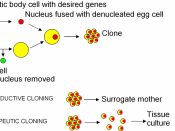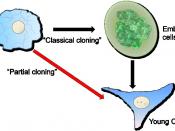The creation of an identical copy of something is the process of cloning. It is simply a form of asexual reproduction. Cloning is a big issue in todayÃÂs world of science because of the potential benefits, the risks involved, and medical, ethical and religious conflicts. Plants and animals have already been cloned and stem cell research is already going ahead, and maybe one day science will be able to clone a human. The division of opinion on cloning will require many forums of discussion to cover all aspects. There are serval types of cloning, Reproductive, therapeutic and DNA cloning.
Any animal created by reproductive cloning is not in fact a perfectly matching copy of its donor. Reproductive cloning involves generating an animal that has the same nuclear DNA as another. The process used for this is called Somatic Cell Nuclear Transfer. Scientists take genetic material from a cell of the adult donor and place it in an egg which has had its nucleus removed.
This egg then must be treated so the process of cell division can start taking place. Once it is ready it will be placed into the uterus of a female to develop until birth.
In 1997, Dolly was the first adult mammal to be cloned. The technique used to clone dolly was the Somatic Cell Nuclear Transfer. She lived for six years and successfully gave birth. Dolly was not perfect though; she suffered from progressive lung cancer, which lead to her early death. Scientists argue whether her early death had anything to do with being a clone. They stated that other sheep had died from this disease and it had no connection with her being a clone.
Dolly was the one success of many attempts. 277 eggs were used and out of them only...



Reference
It seems good essay, it looks that u have done some research for doing this essay. You have a good opening. However, you should put some reference for some data that you mentioned, so you can have strong argument.
0 out of 0 people found this comment useful.